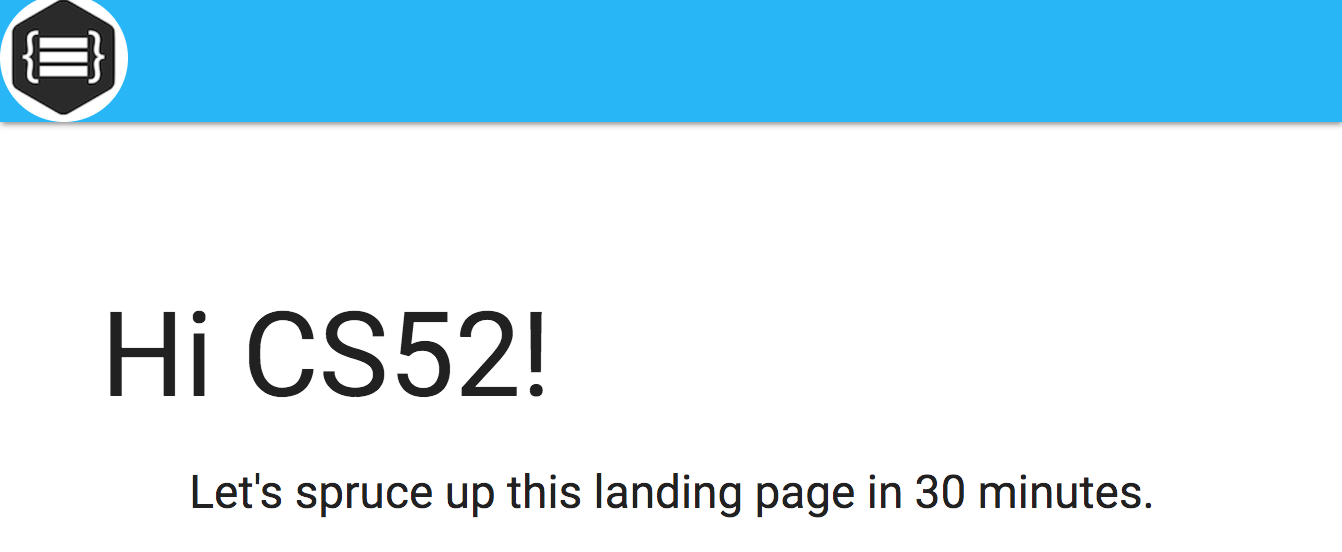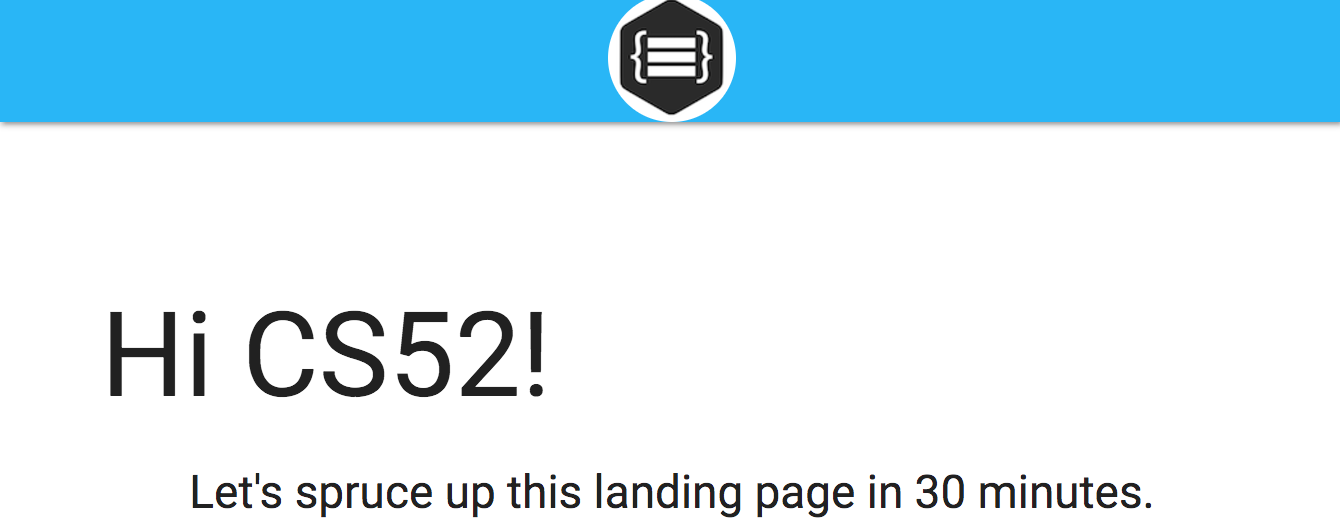Welcome! We're going to build a landing page, so basically what we did last week but better and we'll do it in only 30 minutes. Thanks, Materialize!
We've given you an HTML file that's adapted from one of Materialize's starter template. You'll build a nice custom navbar with the help of the template code provided. We also have a nicely formatted section in the middle for you for some additional customizable content.
🚀 What do you need to add? Better title styles, images, and button effects! Plus, a modal and parallax.
Also, while we go through the tutorial, you might find it helpful to have http://materializecss.com/ open so you can check out cool features, classes, and effects yourself. There's plenty of cool stuff that we won't cover that will make YOUR website much cooler.
🚀 Add in some lines to the head:
<link href="https://fonts.googleapis.com/icon?family=Material+Icons" rel="stylesheet">
<link rel="stylesheet" href="https://cdnjs.cloudflare.com/ajax/libs/materialize/0.98.1/css/materialize.min.css">
And then add this line at the bottom of body right AFTER the jQuery script:
<script src="https://cdnjs.cloudflare.com/ajax/libs/materialize/0.98.1/js/materialize.min.js"></script>
If it's not after the jQuery script, you'll get errors with the CDN script!
🚀 Let's make "Hi CS52" and the text under that stand out.
Find the "Hi CS52!" text. We want h1 to include class="header center orange-text".
Let's also change the text under that. Give h5 some classes. Let's do class="header col s12 light", or some other combination of classes. Up to you!
We are going to build a sweet navbar which you can customize. You'll have a custom Logo and a cool dropdown, demonstrated below:
The dropdown:
🚀 Now, to make the actual navbar, first locate the main <div> inside the <nav> tag and add the following class to it: nav-wrapper. This will apply a specific materialize style to the <div>. You can change the color by adding to the class: light-blue. You can cuztomize the colors in the materialize.cssfile. (What happens if you include: lighten-3?).
🚀 Grab an image from the internet and replace the text that says "LOGO" by adding a image source to the <img> tag in <a href="#"><img>LOGO</img></a>. If you want, you can use our logo in img/logo.png (hint: add a src field)
Once you have successfully replaced the LOGO text with an image, let's try to make the logo appear more pleasant by giving the logo image a circular frame. We can achieve this by adding a circle class to the img tag.
Your logo should now appear something like this:
Is your logo HUGE? The circle class doesn't have resizing in Materialize. We need to overwrite this, so go to the css/style.css file and add this in:
circle {
height: 64px;
width: auto;
}
Now your logo looks too crammed in the corner right? Let's center this logo at the top by adding to the <a> tag. The class brand-logo will center itself on medium and down the screens but you can also add center class if you want the logo to be always centered.
Your logo should appear something like this:
🚀 Now, let's create the right menu items and dropdown by using an unordered list. In the <ul> tag add the class: right hide-on-med-and-down which will create a right oriented menu from the li tags.
On the Assignments item, add dropdown-button to the <a> tag's class to indicate that it will be a dropdown button. Also add the attribute data-activates="dropdown". This will identify the dropdown content defined below - the dropdown is like an id. Lastly, on the inner <i> tag set class to material-icons right to create the little arrow icon. You can experiment with this.
The navbar looks good, but there is no content defined for the dropdown. Let's fix that!
For the ul tag (in the section after </nav>) set the id to dropdown to connect the dropdown button from the menu. Also set the class to dropdown-content to define the ul element as dropdown content. To create the horizontal dividers, you can transform li elements by setting their class to divider.
Finally add $(".dropdown-button").dropdown({ hover: false }); to the document.ready function in the init.js file in the js folder. This will connect the dropdown with the dropdown content. Your navbar should be in good shape now!
🚀 Add some style to the buttons!
For Button 1: replace <button>Button 1</button> with <a class="btn">Button 1</a>. This is a standard button. Notice it already looks good and has a cool hover effect.
Let's add a cool click effect. Instead of just class="btn", make it class="btn waves-effect waves-light". Click the button, it's so cool!
For Button 2, replace the old button with a round button. Do the same thing as Button 1, but instead of btn, use the class btn-floating. You can change the color by adding a class, like cyan. Let's try out Materialize's icon package too. Between <a> and </a>, add in <i class="material-icons">add</i>.
By the end of this, button 2 should look like:
<a class="btn-floating waves-effect waves-light cyan"><i class="material-icons">add</i></a>
For Button 3, replace the old button with <a class="btn btn-floating pulse"><i class="material-icons">cloud</i></a>. Check out the cool effect!
🚀 Let's work on a modal. If you notice now, when you click on the modal button nothing happens. Let's fix that!
First, make sure you've replaced Button 3 with the anchor tag above.
Now let's set the target for the anchor. Add the ID of the modal to the href of the modal anchor, so it reads #getStartedModal
Once that's done, we can start actually constructing the modal. Surround <h4> and <p> with a new div with the class name 'modal-content' - this will tell Materialize where the content of the modal lives
Then, to add some buttons to the bottom, add a footer for the modal. Add a new div with the class 'modal-footer' and then within the modal-footer div, add an anchor (<a>) with the href '#!' and the text 'I'm ready!'
Finally, add some classes to the anchor! You must add 'modal-action' and 'modal-close' for the button to work, but the others are up to you - some ideas are 'waves-effect' and 'btn-flat' - feel free to use some of the styling you learned above!
Now, when you click the modal button you'll notice it's not working yet... why not?!
As it turns out, Materialize makes you initialize their Javascript components. That's easy enough - in the init.js file, add this code below the drop down initializer:
// code from:http://materializecss.com/modals.html#!
// additional help from: http://stackoverflow.com/questions/41626343/materialized-modal-not-displaying
// this initializes all modals so they can be triggered
$('.modal').modal();
This will initialize all modals on the page and let them run.
🚀 Time to add parallax effects! With Materialize this is super easy.
To add parallax, all you have to do is add two parallax containers, one right after nav and before the section-white div, and the other right after the section-white div and before the footer. That's it! Use the following parallax containers, in order:
<!-- parallax code from: http://materializecss.com/parallax.html -->
<div class="parallax-container">
<div class='parallax'><img src='img/p1.jpg'></div>
</div>
<!-- parallax code from: http://materializecss.com/parallax.html -->
<div class="parallax-container">
<div class='parallax'><img src='img/p2.jpg'></div>
</div>
It's not working!!! Why?! It's beacause we still have to initialize - add the following code right after your modal initialization in the init.js file:
// parallax code from: http://materializecss.com/parallax.html
$('.parallax').parallax();
At this point, you should have a decent looking webpage that includes some really interesting features that would be difficult to implement from scratch. Here's a checklist for what you should have:
- added references to Materialize styling
- added logo to top of page
- nav bar drop-down section
- styled some buttons
- added a modal popover to the modal button
- added simple parallax sections
Utilized extensively for tutorial code and for the base template: http://materializecss.com/
Photos from: https://unsplash.com



